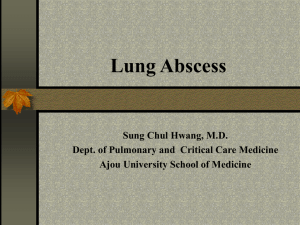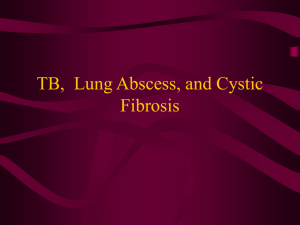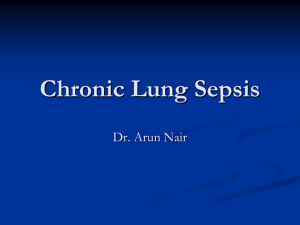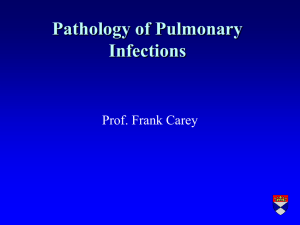lung abscesses
advertisement
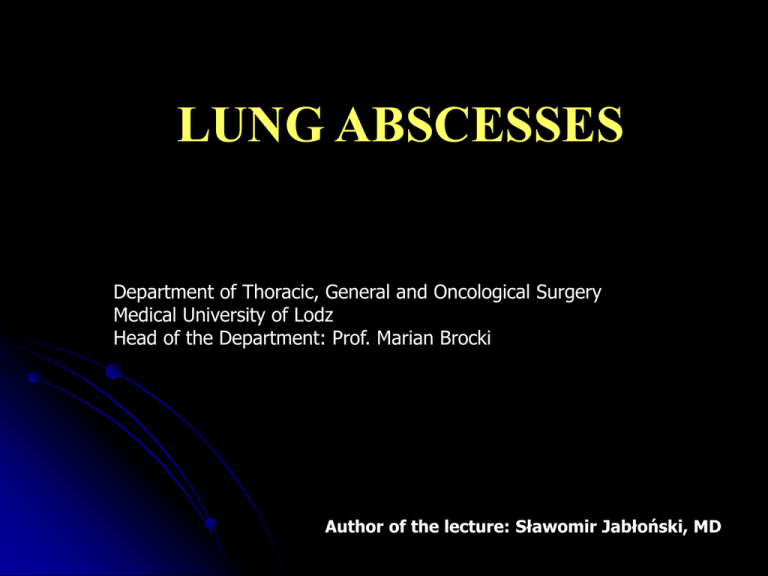
LUNG ABSCESSES Department of Thoracic, General and Oncological Surgery Medical University of Lodz Head of the Department: Prof. Marian Brocki Author of the lecture: Sławomir Jabłoński, MD Lung abscess (abscessus pulmonis) Definition: Lung abscess is a localized area of suppuration and cavitation in the lung being usually a result of bacterial infection or less frequently having other etiology such as viral, mycotic or parasitic invasion. This condition has an acute clinical course at the beginning and then it turns into a chronic phase. The disease is characterized by a cough with the expectoration of foulsmelling purulent or mucopurulent sputum and recurrent subfebrile body temperature. Lung abscess (abscessus pulmonis) Invading microorganisms are responsible for the destruction and necrosis of lung tissue with its quick disintegration followed by the production of pus rich in lytic enzymes released by granulocytes and disintegrated cells and bacteria. The pathological changes within the lung parenchyma leads to the cavitation in the lung that is seen on a thoracic roentgenogram as a spherical opacification with an air-liquid level. Chronic lung abscesses have a capsule formed by granulation and fibrous tissue. Lung abscess (abscessus pulmonis) The following conditions that weaken immune system promote the formation of lung abscesses: diabetes mellitus, malignancy, chronic alcoholism, immunosuppression (leucopenia), irradiation (bone marrow malfunction), chemotherapy, HIV infection, old age. Reports of the cases of multiple lung abscesses caused by salt water aspiration in people who suffered from tsunami in south-eastern Asia have been published lately. Lung abscess (abscessus pulmonis) ETIOLOGY: infections caused by aerobic bacteria (streptococcus pneumoniae, streptococcus pyogenes, staphylococus aereus, klebsiella pneumonie, pseodomonas aeruginosa, proteus vulgaris, escherichia coli, neisseria meningitidis, haemophillus influenzae) Most frequent infections caused by anaerobic bacteria (clostridium hystoliticum, bacteroides fragilis). Mixed (aerobic and anaerobic bacteria) infections ( observed pretty frequently) mycotic infections - infrequent cases, found usually in chronic abscesses caused by protozoa (entamoeba histolytica) diagnosed extremely rarely in our climatic zone Lung abscess (abscessus pulmonis) CLASSIFICATION: PRIMARY (SIMPLE) ABSCESS: Pathological process develops directly within pulmonary parenchyma (e.g. aspiration of septic debris from the oropharynx, gastrointestinal tract into the lung and its retention within the bronchus during periods of unconsciousness from alcoholism, general anesthesia, epilepsy and other neurological disturbances). SECONDARY ABSCESS: Pathological process within pulmonary parenchyma is a result of another disease that can develop in the lung or other organs such as: pneumonitis, bronchial stricture, tuberculosis, septic embolus transported by blood or lymph, vasculitis or neoplastic tumor with necrosis. Lung abscesses can also occur as a result of aspiration of a foreign body into the respiratory tract or its penetration into pulmonary parenchyma from outside (gunshot wounds, shell splinters). Lung abscess (abscessus pulmonis) CLASSIFICATION: SYNPNEUMONIC ABSCESS : Secondary abscess that occurs in pulmonary parenchyma when a pathology that caused it still proceeds. METAPNEUMONIC ABSCESS : Secondary abscess developing in pulmonary parenchyma when the signs and symptoms of a primary pathology have already regressed. Lung abscess (abscessus pulmonis) PATHOGENIC CLASSIFICATION OF LUNG ABSCESSES : ABSCESSES CAUSED BY ASPIRATION OF SEPTIC DEBRIS INTO THE AIRWAYS ABSCESSES CAUSED BY SEPTIC EMBOLISM SECONDARY ABSCESSES BEING THE OUTCOME OF ANOTHER PRIMARY DISEASE (E.G. PNEUMONIA, TUBERCULOSIS, NEOPLASIA) ABSCESSES CAUSED BY THE TRANSITION OF INFLAMMATION FROM ADJACENT TISSUE INTO THE LUNG PARENCHYMA (CHEST WALL INFECTION; MEDIASTINITIS; SUBPHRENIC, PERIESOPHAGEAL OR OTHER ABSCESSES). Lung abscess (abscessus pulmonis) SIGNS AND SYMPTOMS : hectic fever, shivering, paroxysmal cough, expectoration of purulent sputum , chest pain, weight loss, dyspnea hemoptysis Clinical presentation of lung abscess is not always typical. The course of the disease depends on many factors such as virulence of microorganisms; immunological response, concomitant diseases; localization and diameter of abscess; efficacy of treatment. Lung abscess (abscessus pulmonis) NEGATIVE PROGNOSTIC FACTORS : large abscess, abscess localized within the right inferior lung lobe, patient’s bad general state (anemia, hypoproteinemia, alcoholism, drug addiction), weakening of immune system, infection caused by virulent bacterial strains - Pseudomonas aeruginosa – mortality approx. 83%, - Staphylococus aureus – 50%, - Klebsiella pneumoniae - 44%. (Boaz Hirshberg, Miri Sklair-Levi, Ran Nir-Paz, Liat Ben-Sira, et al. Factors predicting mortality of patients with lung abscess Chest. Chicago: Mar 1999. Vol.115, Iss. 3; pg. 746, 5 pgs) Lung abscess (abscessus pulmonis) LOCAL COMPLICATION OF LUNG ABSCESS : bronchogenic spread (multiple abscesses), pleural empyema, formation of bronchial fistula accompanied by pneumothorax, soft tissues inflammation or phlegmon of the chest wall, pulmonary hemorrhage , fungal infection Lung abscess (abscessus pulmonis) REMOTE COMPLICATIONS OF LUNG ABSCESS: hematogenous lesion of myocardium , multiple intrahepatic abscesses, metastatic brain abscesses, nephritis, renal amyloidosis, septicemia, multiorgan failure Mortality of patients suffering from lung abscess is still high and ranges from 15% to 20%. (Bartlett JG. Lung abscess. In: Baum GL, Wolinsky E, eds. Textbook of pulmonary diseases. 5th ed. Boston, MA: Little, Brown and Company, 1994; 607-620. ) Lung abscess (abscessus pulmonis) DIAGNOSIS OF LUNG ABSCESS: clinical picture, x-ray chest film, computed tomography of the thorax, bronchoscopy, bacteriological investigation of of sputum, bacteriological investigation of bronchial washings, bacteriological and biochemical examination of material obtained by thoracocentesis, laboratory examinations ( increased erythrocyte sedimentation reaction, leucocytosis) immunoglobulin level Lung abscess (abscessus pulmonis) ROENTGENOGRAPHIC PICTURE OF LUNG ABSCESS: In the early stages of lung abscess roentgenograms show a spherical, oval or irregular area of dense pneumonic consolidation with blurred borders. When the disease proceeds the borders between abscess and pulmonary parenchyma are more and more sharper as an abscess capsule forms. If there is a connection between an abscess cavity and the bronchus a pathognomonic roentgenographic picture of thick-walled cavity with air-fluid level is seen. Lung abscess can resemble a cyst, tuberculous cavity, mycotic cavity or a cavitation of a neoplastic tumor on a x-ray chest film. The rupture of lung abscess into the pleural cavity causes pneumothorax. As a result of the transition of infection into the pleural cavity due to abscess rupture or contact infection roentgenograms show pleural effusion (hydrothorax) or empyema (empyema). Radiological pictures of lung abscess Radiological pictures of lung abscess Computed tomography – lung abcess Lung abscess (abscessus pulmonis) CONSERVATIVE THERAPY: Contemporarily most of lung abscess cases can be treated conservatively using antibiotics that are selected on the basis of cultures of material obtained from the respiratory tract or directly from abscess cavity. Conservative treatment can be accompanied by other therapeutic methods such as mucolitic drugs, bronchodilating drugs, antiinflammatory drugs, physiotherapy, bronchoaspiration, nutritional treatment and agents stimulating immune system. Lung abscess (abscessus pulmonis) THERAPY: It is thought that lung abscess in its early stage can regress spontaneously in approximately 20-30% of cases. If conservative treatment is ineffective or complications are observed adequate invasive or surgical treatment should be initiate. It is estimated that invasive treatment by intercostal tube drainage or surgery is indispensable in 11-12% of patients in whom antibiotic therapy was ineffective. (Estrera AS, Platt MR, Mills LJ, et al. Primary lung abscess. J Thorac Cardiovasc Surg 1980; 79:275-282). Lung abscess (abscessus pulmonis) INVASIVE THERAPY: INJECTION OF THERAPEUTIC AGENTS DIRECTLY INTO AN ABSCESS CAVITY: The abscess is punctured through the chest wall and antibiotics are injected directly into its cavity. This method is suitable for large peripheral abscesses where the visceral and parietal pleura are accreted. The method is burdened with a risk of pneumothorax or empyema formation. ENDOSCOPIC ABSCESS EVACUATION: If lung abscess is a result of pathology of the bronchial tree with its obstruction and retention of septic debris within bronchi distally to the level of obstruction bronchoscopy is an effective technique for abscess evacuation. The abscess evacuation can be completed by the injection of antibiotic into the abscess cavity. Lung abscess (abscessus pulmonis) INVASIVE MANAGEMENT: CAVERNOSTOMY: A method used in selected cases of lung abscess (Monaldi procedure). Obliteration of the pleural cavity is an indispensable condition to perform this procedure. Short fragments of two or three ribs are resected over a place where the distance between an abscess capsule and the chest wall is the shortest. The surface of the lung is visualized and the abscess cavity is opened. Then the abscess cavity is packed with gauze saturated with an antiseptic solution. The gauze is changed regularly for several weeks until the process of healing and contraction of a lung defect is obtained. PERCUTANEOUS CATHETER DRAINAGE Percutaneous catheter drainage of lung abscess under fluoroscopic or computed tomography guidance is a technique introduced into medical practice during last three decades and brings relatively good results in selected cases. The limitation of this method is a localization of an abscess near important anatomical structures that makes an introduction of a catheter hazardous. The technique is burdened with some serious complications such as pneumothorax accompanied by a brocho-pleural fistula, pleural empyema, hemorrhage and cardiac arrest. Lung abscess (abscessus pulmonis) INVASIVE MANAGEMENT: ENDOSCOPIC DRAINAGE: This technique is suitable for lung abscesses having a contact with the bronchus. A flexible bronchoscope is introduced into the bronchial tree with its end-part as close as possible to an abscess cavity. Then a guide-wire is inserted through a bronchoscope tool channel under fluoroscopic guidance directly into the abscess cavity. When fluoroscopy shows that the guide-wire is in a proper position a 90 cm long 7F catheter (pigtail catheter - Cordis; Miami, FL) is introduced along the guide-wire into the abscess cavity. To check a proper position of the catheter a non-barite contrast medium ( Isovist-300) can be injected into the abscess cavity through this catheter. The proximal end of the catheter is brought out through the nostril. The method enables the evacuation of liquid content of abscess and abscess cavity irrigation with antibiotic or antifungal (Amphotericin B) solutions. The catheter is kept within the abscess cavity from 3 to 21 days. The technique offers gradual sterilization and obliteration of abscess . Lung abscess (abscessus pulmonis) SURGICAL MANAGEMENT: The resection of pulmonary parenchyma with abscess is a radical method of treatment that, however, can’t be used too often due to its potential serious septic complications and usually a bad patient’s general state. Surgery is advocated if medical treatment and minimally invasive techniques appeared ineffective or some complications that can be managed only by surgery ensued. The resection of pulmonary parenchyma with abscess is curative in approximately 90% of patients but it must be highlighted that postoperative course is burdened with high mortality estimated at 11%-28%. Lung abscess (abscessus pulmonis) INDICATIONS FOR SURGICAL INTERVENTION: pulmonary hemorrhage caused by abscess, pleural empyema , broncho-pleural fistula, ineffective medical treatment, presence of foreign body within abscess, vast pulmonary parenchyma destruction, probable malignant etiology of abscess. Lung abscess (abscessus pulmonis) METHODS OF SURGICAL TREATMENT: A type of resection of pulmonary parenchyma is dependent on localization and size of abscess and a patient’s general state. NON-ANATOMICAL LUNG RESECTION Marginal or wedge pulmonary parenchyma resection for abscesses using linear staplers: TA and GIA type is effective for small lesions localized peripherally. ANATOMICAL LUNG RESECTION Large lung abscesses, abscesses localized deeply in pulmonary parenchyma and multiple lung abscesses are all indications for anatomical resections. The most frequent procedures are resections of a pulmonary lobe (lobectomy) or resection of two pulmonary lobes of the right lung (bilobectomy). In the cases of solitary abscess or multiple abscesses with vast destruction of the lung the resection of the whole lung (pneumonectomy) is sometimes necessary. Local conditions rarely enable less extensive surgical procedures such as semisegmentectomy or bisegmentectomy. Lung abscess(abscessus pulmonis) METHODS OF SURGICAL TREATMENT : VATS (Video Assisted Thoracic Surgery) A method that is a combination of minithoracotomy and videothoracoscopic technique (video telescope and endoscopic instruments). It enables resection of some small, peripherally localized abscesses. DECORTICATION + LUNG RESECTION A method used for the treatment of lung abscesses accompanied by pleural empyema. Decortication consists in the removal of a thick fibrinopurulent coat from the lung surface. Besides it the part of a pleural empyema capsule that covers the internal surface of the chest wall is also resected along with the parietal pleura. The procedure is completed by resection of pulmonary parenchyma with abscess. LUNG RESECTION + IRRIGATING DRAINAGE A procedure used in the cases of lung abscess coexisting with acute pleural empyema. When pulmonary parenchyma with lung abscess is resected two or three tubes are introduced into the pleural cavity and continuous irrigating drainage with antibiotic or antiseptic solution is carried out.
